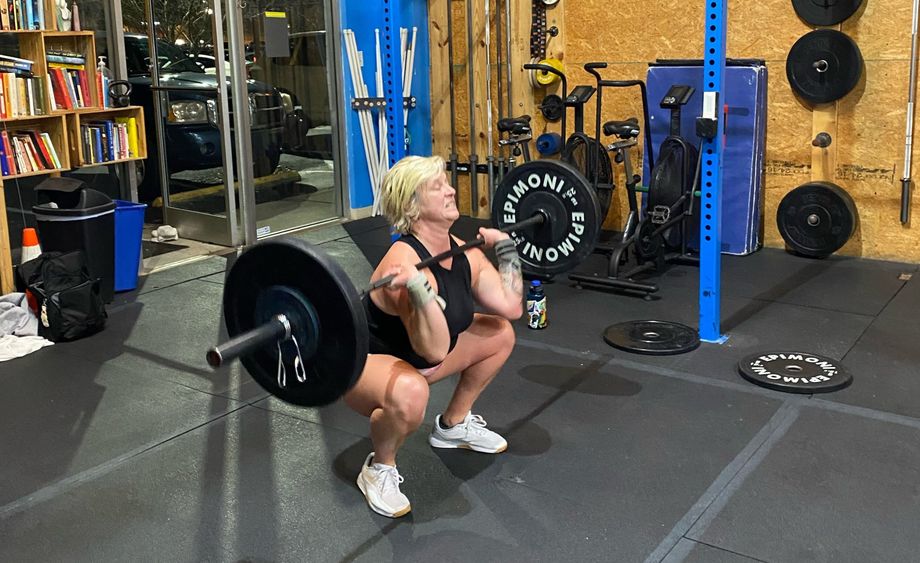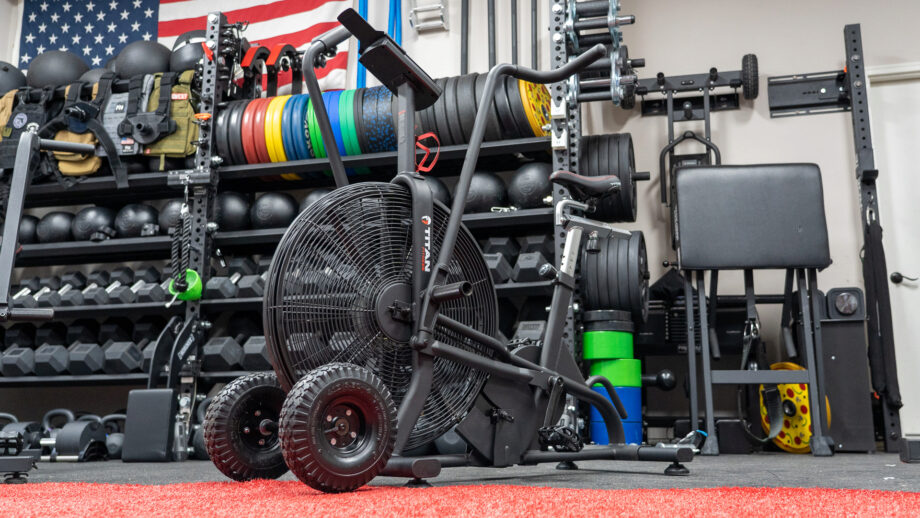Few fitness phenomena have garnered as much attention as CrossFit, with an estimated 4 million people practicing CrossFit today, and we totally understand why. CrossFit’s approach combines elements of HIIT, functional movements, and Olympic weightlifting to create one of the most comprehensive programs on the planet.
RELATED: What is Functional Fitness?
Unfortunately, some of what makes CrossFit so great has also acted as an entry barrier, leading beginners to believe that only elite athletes should practice CrossFit.
But that’s not true; CrossFit is for everyone, from teens to seniors to average folks and athletes alike. So long as CrossFit exercises are done with proper form, they are an excellent addition to any workout routine.
RELATED: Best CrossFit Training Programs
We put together this beginner’s guide to CrossFit exercises, including what they are and how to do them. Check it out!
What Is CrossFit, Exactly?
CrossFit is an exercise program that blends functional movements, high-intensity interval training (HIIT), gymnastics, and Olympic weightlifting.
RELATED: Benefits of HIIT Training
The CrossFit program is designed to enhance functional fitness and improve athletic performance of its practitioners while staying varied enough to stave off boredom and create muscle confusion1.
Class structure varies, depending on what CrossFit gym or “box” you visit, but typically include a strength section, which focuses on heavy weightlifting and weightlifting technique, and a conditioning section, during which the members perform the “WOD” or “workout of the day.”
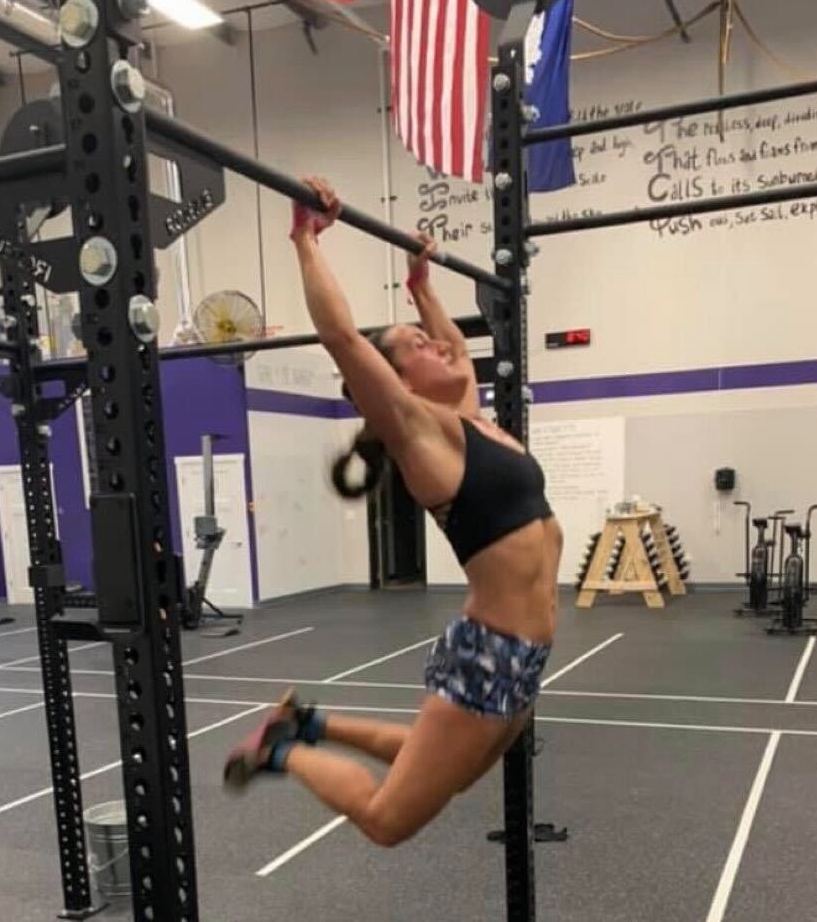
RELATED: 100+ CrossFit WODs for Hypertrophy
The WOD is where the CrossFit program truly shines. Members are awarded a score based on their performance for each WOD, essentially turning their workout into a game.
According to a 2022 review published in the Journal of Medical Internet Research2, “gamified interventions,” or fitness programs that incorporate elements of game playing, “are promising for promoting [physical activity] in various populations.”
So, to put it in simple terms, CrossFit is an all-encompassing exercise program that is both effective and fun!
CrossFit Exercises
You can’t create the same competitive atmosphere and camaraderie in your own home gym, but you can use the same exercises to perform authentic CrossFit workouts from the comfort of home.
We’re covering all the CrossFit exercises that make the program so darn good, from clean and jerks to box jumps, burpees, wall balls, and more.
Without further ado, the CrossFit exercises you need to know!
Cleans
Full Clean (Squat Clean)
The full clean, or squat clean, involves lifting the best Olympic barbell from the floor to the shoulders.
How to do it:
- Stand behind a loaded barbell with your feet hip-width apart.
- Grab the bar with an overhand or hook grip.
- Drive through your heels, as though about to stand, and extend your hips and knees, simultaneously pulling the bar from the floor. Keep the bar close to your body.
- As the bar reaches stomach level, drive your elbows forward and drop your body beneath the bar to catch it in the front rack position.
- Push through your heels to return to a standing position.
RELATED: Best CrossFit Grips
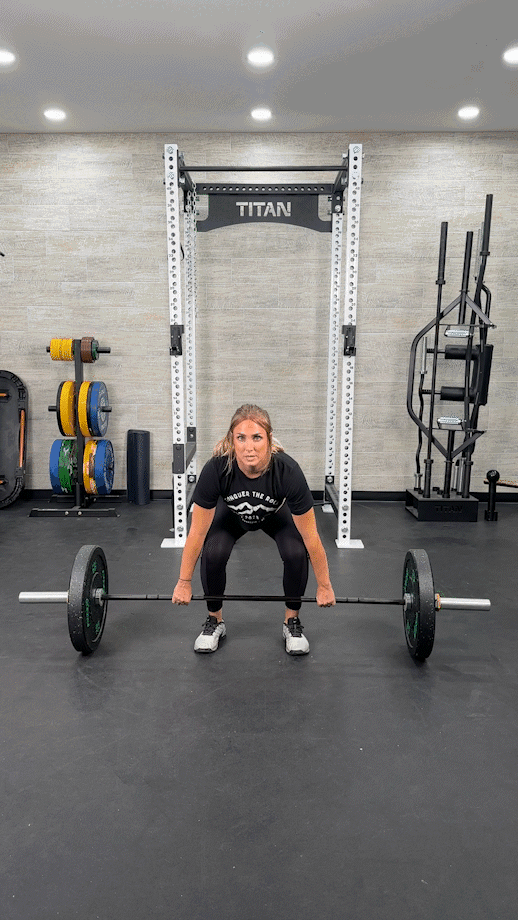
Hang Squat Clean
The key differences between the hang squat clean and full squat clean are the starting position and the range of motion. Hang squat cleans begin from the hang position, which is located between the knees and the waist.
How to do it:
- Stand with your feet hip-width apart while holding a loaded barbell in the hang position.
- Dip slightly, then explosively drive through your heels and pull the bar to your chin.
- Drop beneath the bar to catch it in a squat position.
- Push through your heels to return to a standing position.
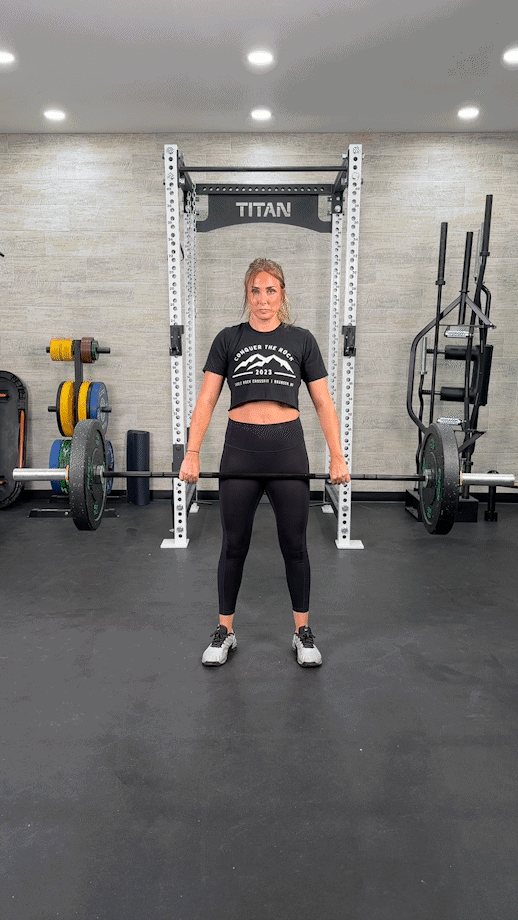
Power Clean
The power clean involves catching the bar in the power position rather than the squat position. Instead of squatting, you’ll catch the bar with a tall torso, bent knees, and feet firmly planted.
How to do it:
- Stand behind a loaded barbell with your feet hip-width apart.
- Grab the bar with an overhand or hook grip.
- Drive through your heels, explosively extend your hips and knees, and pull the bar towards your chin, keeping it close to the body.
- Drive your elbows forward and under the bar, catching it in the front rack position. You may dip slightly, but do not drop into a full squat.
- Fully extend your hips and knees to complete the rep.
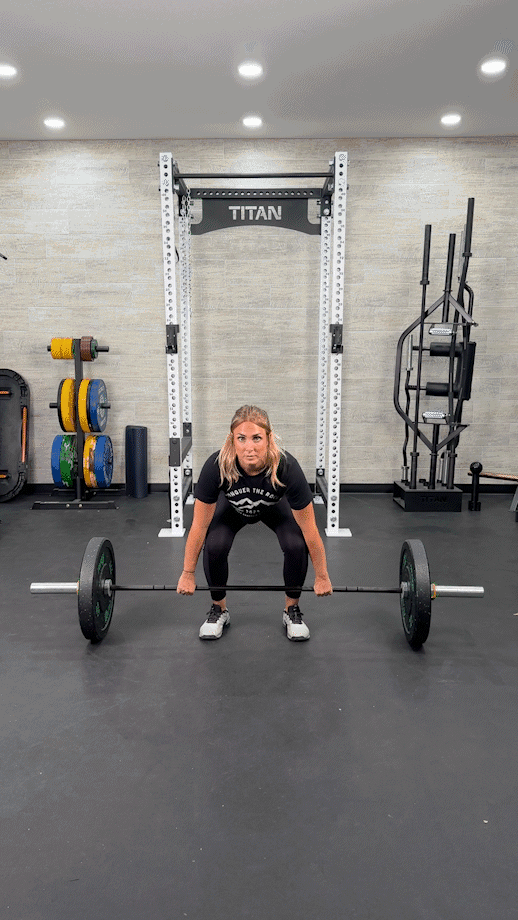
Hang Power Clean
The hang power clean reduces the range of motion by starting from the hang position. It’s a great movement for developing explosive power, coordination, and overall upper body strength.
How to do it:
- Stand with your feet hip-width apart while holding a loaded barbell in the hang position.
- Dip slightly, then explosively drive through your heels and pull the bar to your chin.
- Drive your elbows forward and under the bar to catch.
- Fully extend your hips and knees.
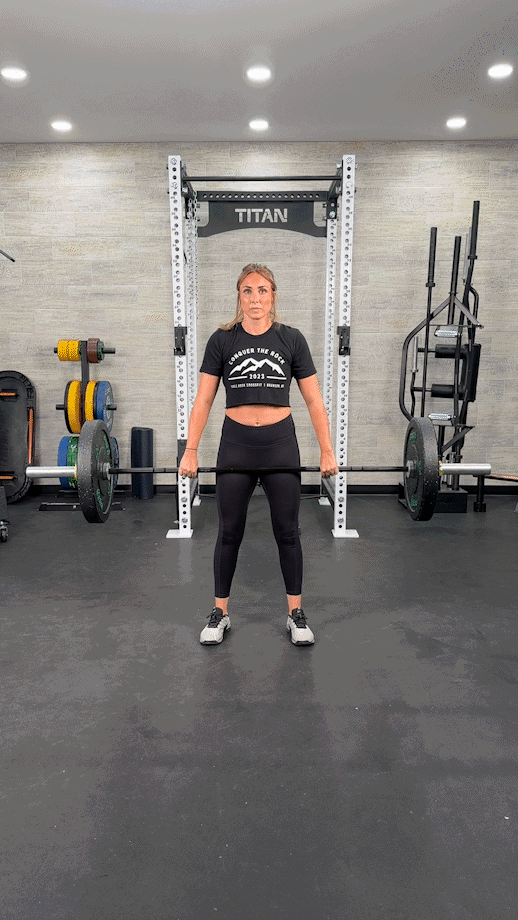
Dumbbell Clean
The dumbbell clean requires strength and coordination, just like the barbell version, but you’ll also need to account for the added challenge of stabilizing each dumbbell individually.
How to do it:
- Place a pair of dumbbells on the floor. Reach down and grip them with an overhand grip.
- Drive through your heels and pull the dumbbells towards your shoulders.
- Push your elbows forward to catch the dumbbells at shoulder height.
- Fully extend your hips and knees to complete the rep.
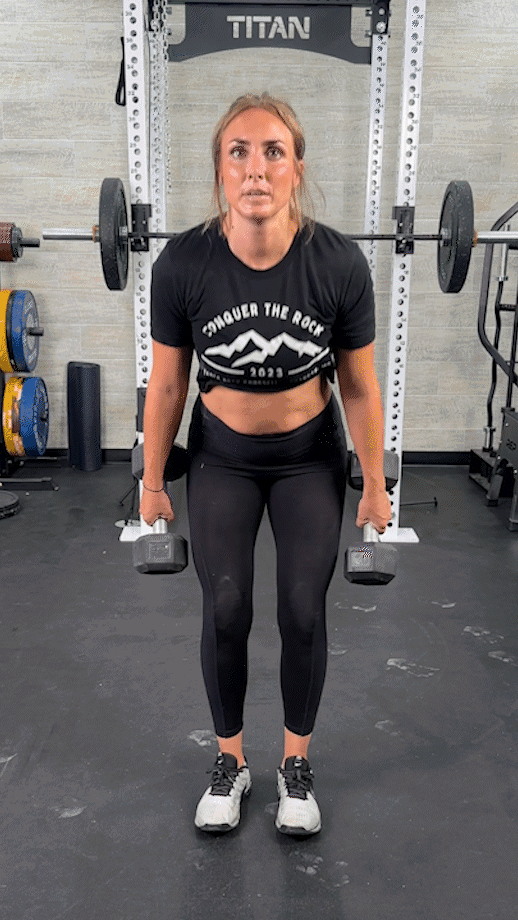
Snatches
Full Snatch (Squat Snatch)
The snatch is an explosive Olympic lift that requires strength, technique, and power to perform. It involves lifting a barbell from the floor to the overhead position in one fluid motion.
How to do it:
- Stand behind a loaded barbell with your feet hip-width apart and toes slightly turned out.
- Grab the bar with a wide (outside shoulder-width) overhand or hook grip.
- Drive through your heels; as though about to stand and extend your hips and knees, simultaneously pulling the bar from the floor. Keep the bar close to your body.
- As the bar reaches thigh level, pull your elbows high and push the bar overhead.
- Drop beneath the bar, then push through your heels to fully stand.
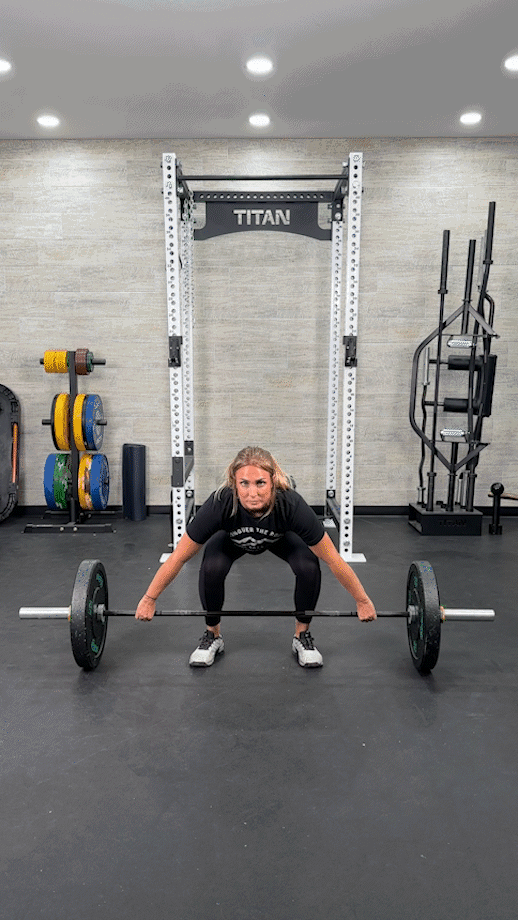
Hang Squat Snatch
The hang squat snatch involves snatching the bar from the hang position instead of the floor.
How to do it:
- Stand with your feet hip-width apart, holding the bar in the hang position.
- Dip slightly, then extend your hips and knees, simultaneously pulling the bar upward.
- Pull your elbows high and push the bar overhead, dropping into a squat.
- Push through your heels to fully stand and complete the rep.
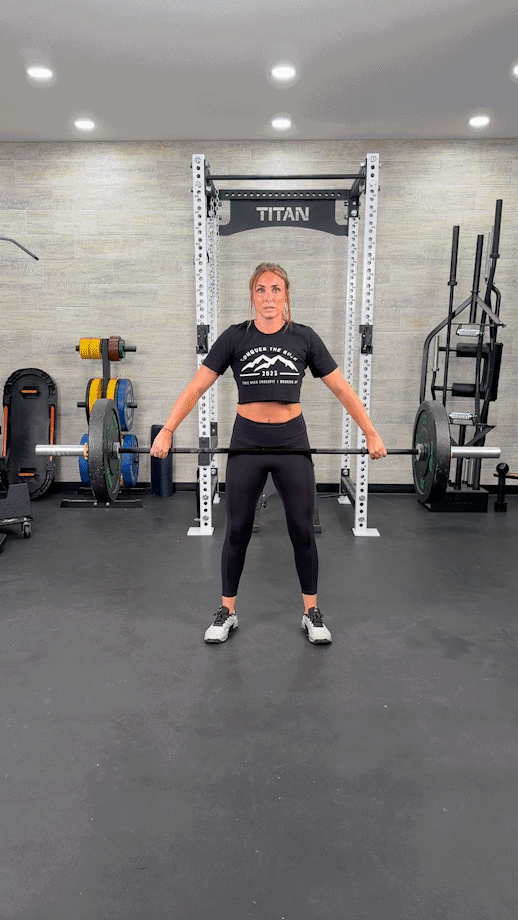
Power Snatch
The power snatch is just like the squat snatch except, instead of catching the bar in a squat, you’re catching it in the power position.
How to do it:
- Stand behind a loaded barbell with your feet hip-width apart and toes slightly turned out.
- Grab the bar with a wide (outside shoulder-width) overhand or hook grip.
- Drive through your heels, extend your hips and knees, and pull the bar from the floor.
- Pull your elbows high and push the bar overhead. You may dip slightly, but do not drop into a full squat.
- Fully extend your hips and knees to complete the rep.
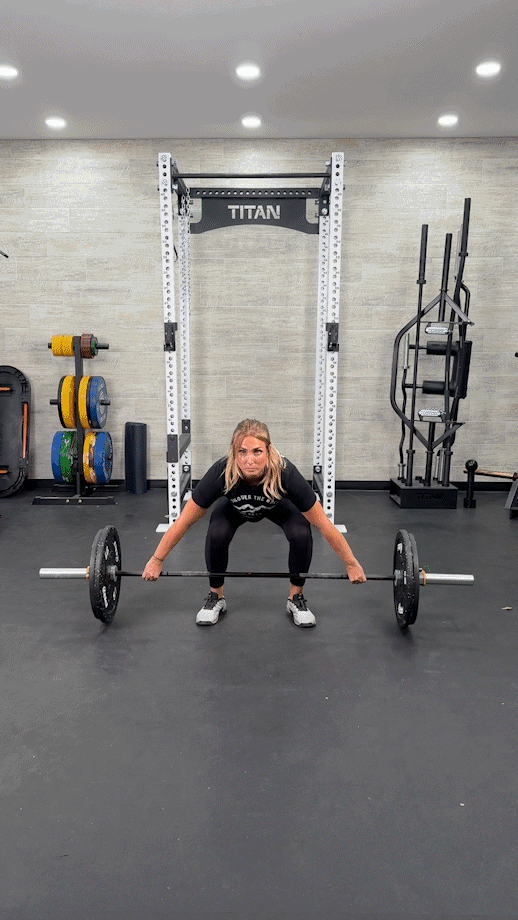
Hang Power Snatch
The hang power snatch is like the regular power snatch, but you start from the hang position.
How to do it:
- Stand with your feet hip-width apart while holding the bar in the hang position.
- Dip slightly, then extend your hips and knees and pull the bar upward.
- Pull your elbows high and push the bar overhead. You may dip, but do not squat.
- Fully extend your hips and knees to complete the rep.
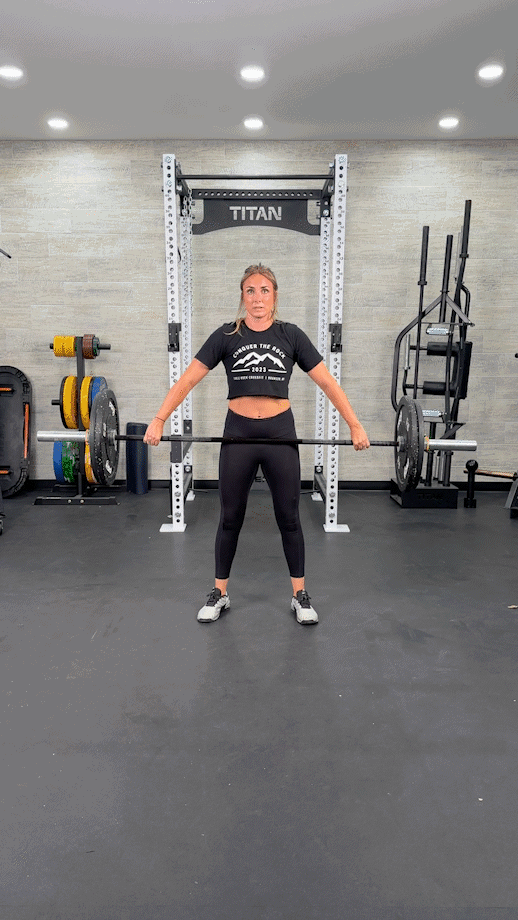
Dumbbell Snatch
The dumbbell snatch trades the barbell in exchange for one or two dumbbells. A popular way of performing the exercise is by doing one arm at a time and alternating sides.
How to do it:
- Place a dumbbell on the floor and stand with your feet hip-width apart.
- Grab the dumbbell, drive through your heels, and extend your knees and hips as you push the dumbbell overhead.
- Slowly return the dumbbell to the floor by reversing the steps.
- Switch sides and repeat for your other arm.
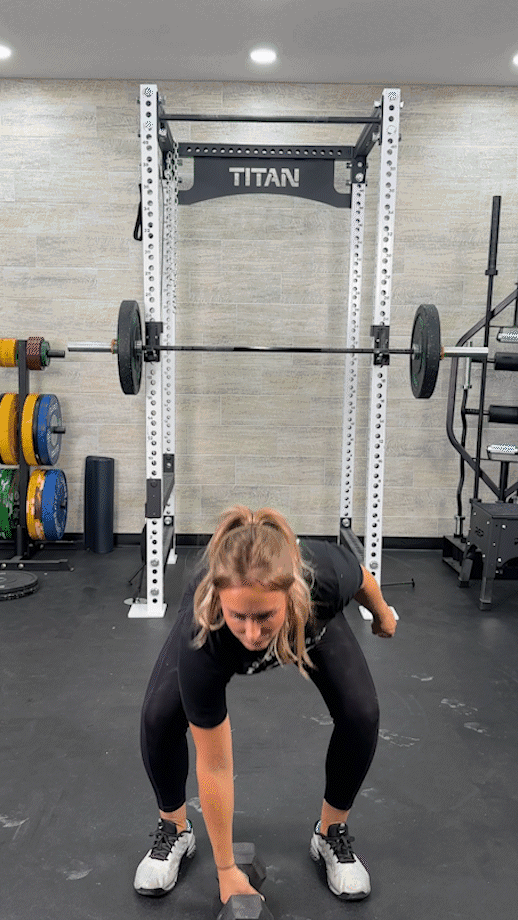
Presses
Strict Press
The strict press involves moving the weight from the front rack position to the overhead lockout position. It’s sometimes called the shoulder press, overhead press, or military press as well.
How to do it:
- Place a barbell on a rack and load it to the desired weight.
- Unrack the barbell into the front rack position.
- Press the barbell overhead using your shoulders and triceps.
- Slowly lower the bar back down.
RELATED: Best Shoulder Exercises
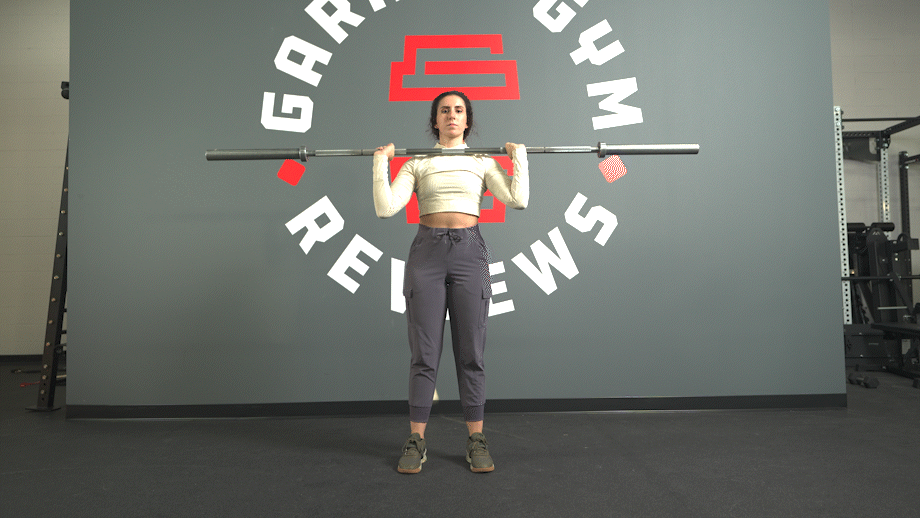
Push Press
The push press recruits lower body muscles, like the glutes and the quads, to allow the lifter to lift more weight than the strict press.
How to do it:
- Load and unrack a barbell into the front rack position.
- Bend your knees slightly, bringing your hips back, then extend them both quickly as you press the bar overhead. Squeeze your glutes and your traps at the top.
- Slowly lower the bar back down.
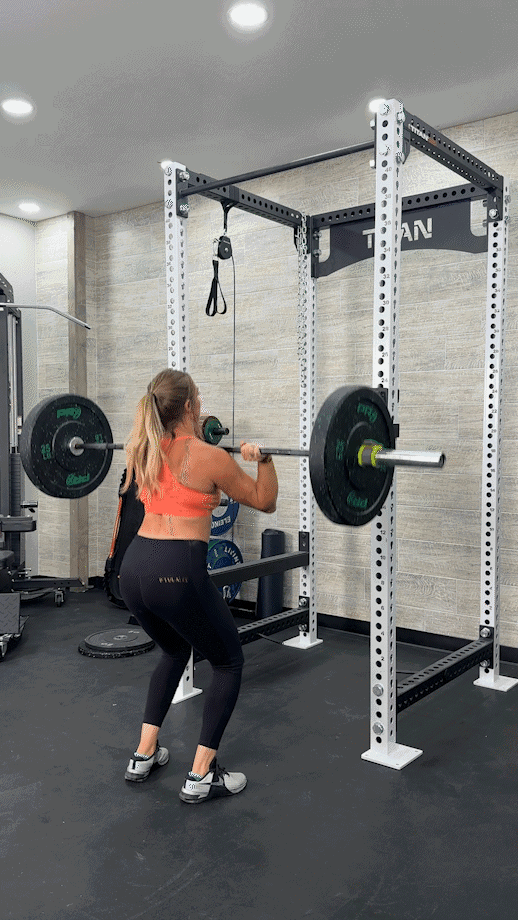
Push Jerk
The push jerk adds in even more lower body assistance, as you’re essentially ducking under the bar as it moves overhead. You should be able to lift even more weight using the push jerk.
How to do it:
- Load and unrack a barbell into the front rack position.
- Bend your knees slightly, bringing your hips back, then extend them both quickly as you propel the bar overhead. Simultaneously, drop into a partial squat and stabilize the bar.
- Fully extend the hips and knees to return to a standing position.
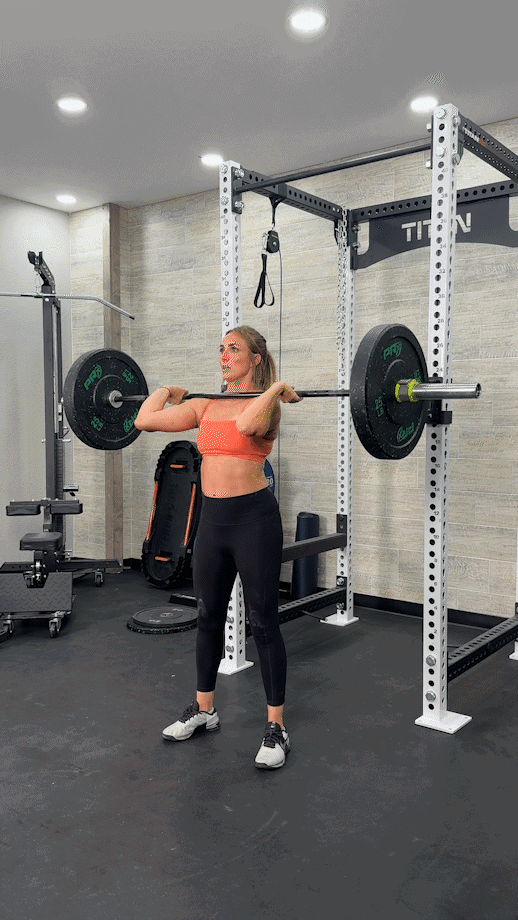
Split Jerk
For competitive weightlifters, the split jerk is the standard. It’s a similar movement pattern to the push jerk, except the lifter enters a staggered stance to create maximum stability.
How to do it:
- Load and unrack a barbell into the front rack position.
- Bend your knees slightly, bringing your hips back, then jump into the air, bringing one foot forward and one foot back to enter a half-lunge stance.
- Stabilize the bar overhead, then step your front foot to center, back foot to center, and fully stand before resetting and repeating.
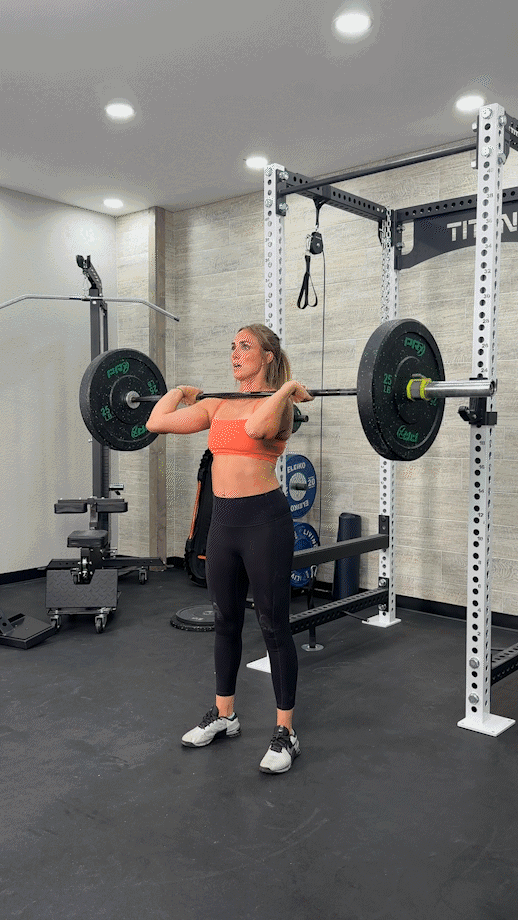
Squats
Back Squat
The back squat is a fundamental exercise that targets various muscle groups throughout the body, including the glutes, quads, hamstrings, core, and lower back.
RELATED: What Muscles Do Squats Work?
How to do it:
- Unrack a loaded barbell onto your shoulders and upper back.
- With your weight on your heels, bring your hips back and bend your knees to descend.
- Continue until your thighs are nearly parallel with the floor.
- Pause, then drive from the heels to return to a standing position.
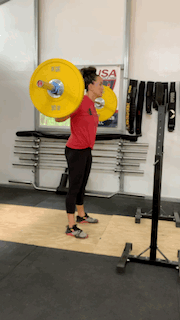
Front Squat
The front squat places the barbell in front of the body, resting across your shoulders and upper chest, creating a greater range of motion and increased core activation.
How to do it:
- Unrack a loaded barbell onto your shoulders and upper chest.
- With your weight on your heels, bring your hips back and bend your knees to descend.
- Continue until your thighs are nearly parallel with the floor.
- Pause, then drive from the heels to return to a standing position.
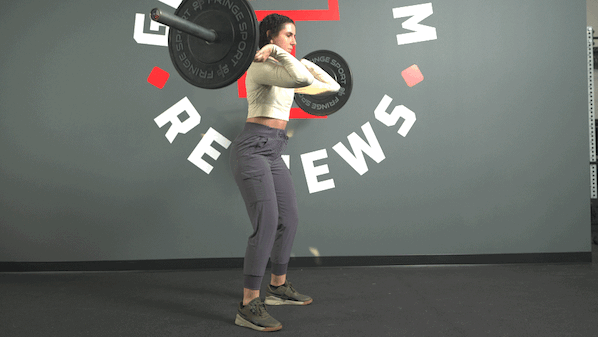
Overhead Squat
The overhead squat is the most challenging variation. It requires you to hold a barbell in the overhead lockout position as you squat, challenging your traps, delts, and lower body.
How to do it:
- Press or snatch a loaded barbell into the overhead lockout position.
- Squat as normal, keeping the barbell stabilized overhead as you move.
- Continue descending until your thighs are nearly parallel with the floor.
- Pause, then drive from the heels to return to a standing position.
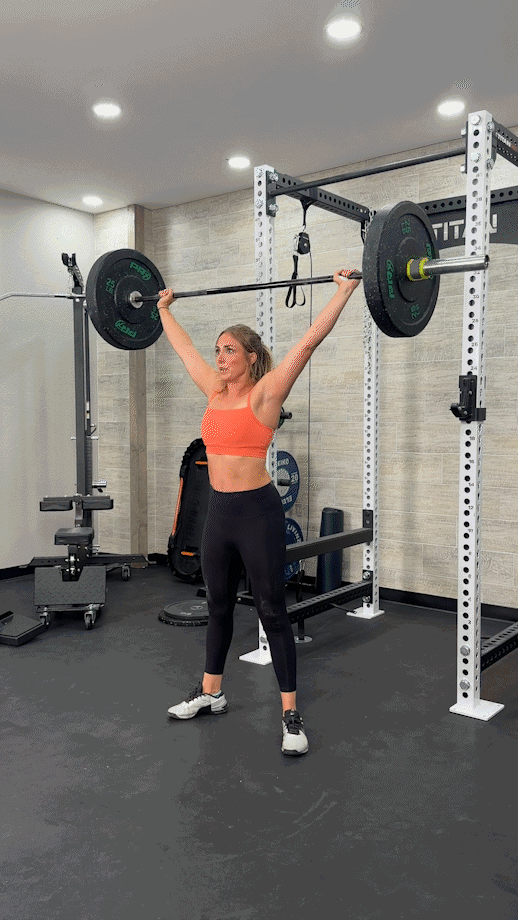
Deadlifts
Conventional Deadlift
The conventional deadlift involves lifting a heavy barbell off the floor, targeting muscle groups throughout the body to build greater overall strength.
RELATED: Deadlift Muscles Worked
How to do it:
- Stand with your feet shoulder-width apart and a loaded barbell in front of you.
- Reach down and grip the barbell with an overhand, hook, or mixed grip.
- Drive from the heels to stand straight up, keeping the bar close to the body.
- Pause briefly, then slowly return to the starting position.
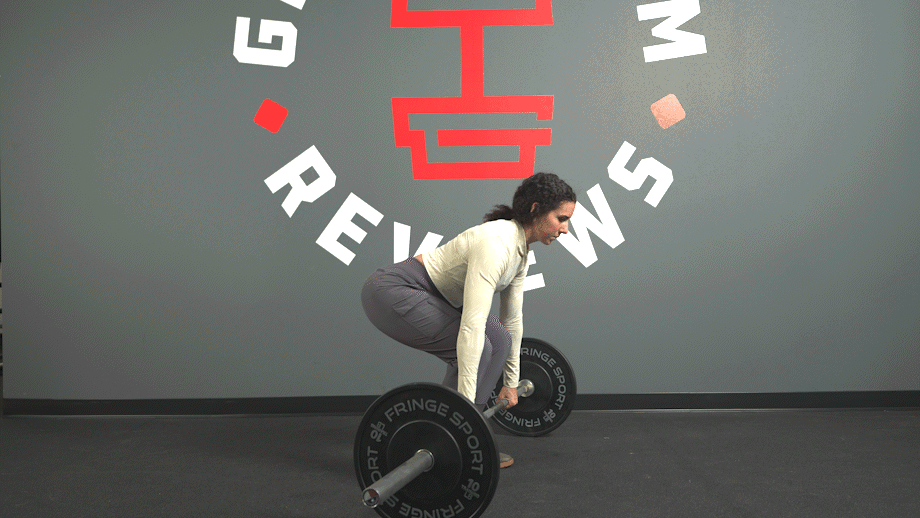
Snatch-Grip Deadlift
The wider grip of the snatch-grip deadlift encourages greater activation of the shoulders and upper back muscles. It also translates nicely to the actual snatch exercise.
How to do it:
- Stand with your feet shoulder-width apart and a loaded barbell in front of you.
- Reach down and grip the bar with a grip that’s wider than shoulder-width.
- Drive from the heels to stand straight up, keeping the bar close to the body.
- Pause briefly, then slowly return to the starting position.
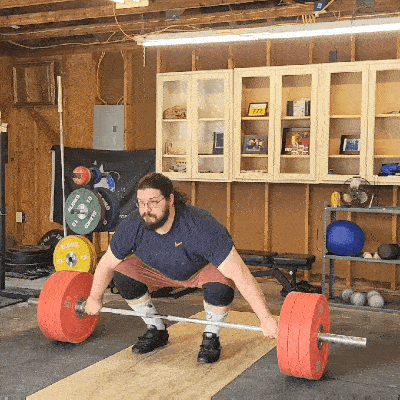
Gymnastics
Ring Rows
Ring rows are a bodyweight exercise that uses gymnastics rings or suspension trainers. They build back muscles, core strength, and work as a pull-up progression.
How to do it:
- Set the rings to waist height and grab hold.
- Walk your feet out to the desired level of difficulty. The closer your feet are to the rings, the easier the movement will feel.
- Fully extend your arms to get into your starting position.
- Keeping your elbows into the body, pull your chest towards the rings.
- Lower yourself back to the starting position.
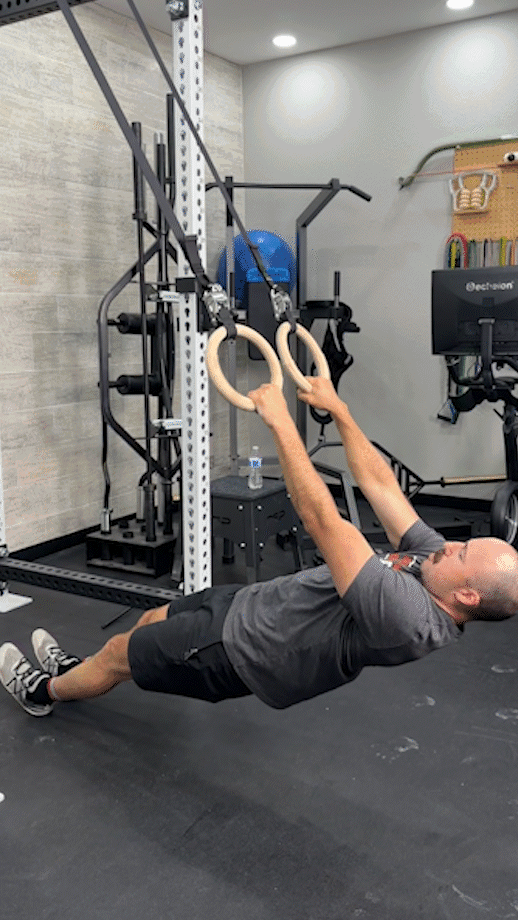
Kipping Pull-Ups
Kipping pull-ups allow you to use your hips and legs to “kip” your way up to the bar. They’re faster than regular pull-ups, making them popular during a WOD, but won’t build muscle as effectively since the form is less strict.
How to do it:
- Grab a pull-up bar with an overhand grip.
- Start swinging back and forth. As your legs will come forward on the backswing, close your hips, then pop them open quickly while pulling hard with your arms.
- Pull your chin over the bar, bringing your shoulders and elbows down.
- Push away from the bar to swing back down and cycle into the next rep.
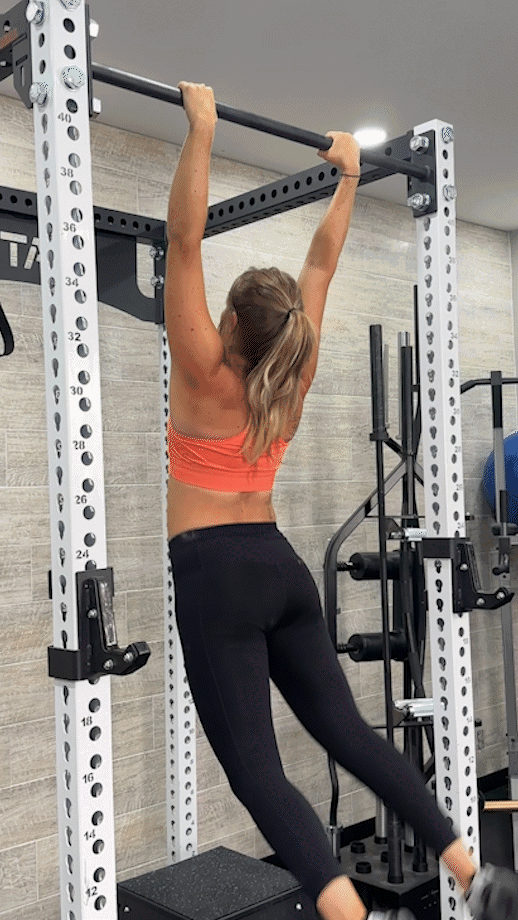
Chest-to-Bar Pull-Ups
Chest-to-bar pull-ups increase the range of motion by requiring you to bring your chest to the bar rather than just get your chin over the bar. Chest-to-bar pull-ups may be performed strict or kipping.
How to do it:
- Grab a pull-up bar with an overhand grip and enter a dead hang.
- Pull your body to the bar using your arms, shoulders, and back muscles until your chest touches the bar. Squeeze your lats at the top.
- Slowly lower yourself back down.
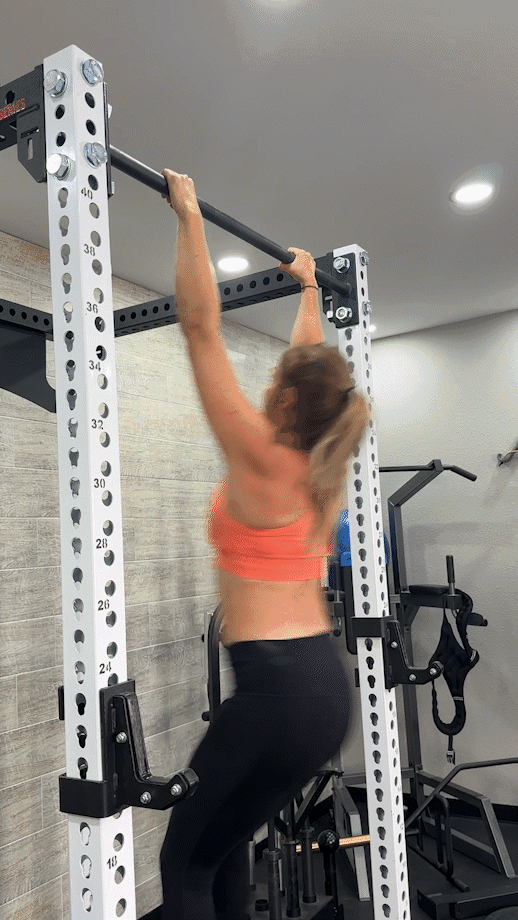
Bar Muscle-Ups
Bar muscle-ups are an extremely challenging gymnastics movement that involves bringing your body from below to above the bar in one fluid motion. Most CrossFitters use momentum to accomplish this, but they can be performed strict if you have great upper body strength.
How to do it:
- Grab a pull-up bar and start to swing.
- As with the kipping pull-up, pop your hips on the backswing and pull hard with your arms. Your goal is to get your waist to the bar.
- As you come closer to the bar, bring your head to the other side of the bar. Imagine you are wearing a hat and you’re trying to throw it off your head with force.
- Once you’re over the bar, extend your arms to push yourself straight up.
- Allow your body to fall back down to the starting position, then cycle into the next rep.
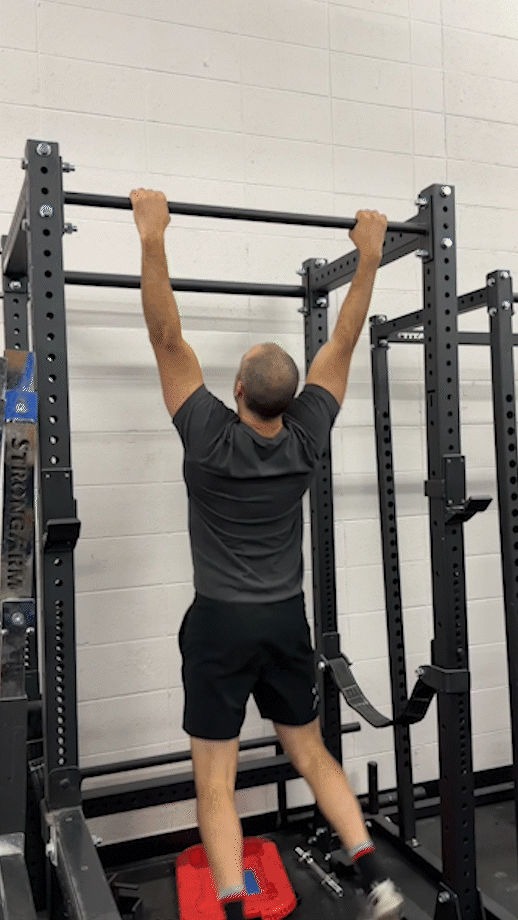
Ring Muscle-Ups
Ring muscle-ups are even more challenging than bar muscle-ups because they add an element of instability. You’ll need even more strength and coordination in order to succeed.
How to do it:
- Set two gymnastics rings so they hang overhead, then grab hold.
- Swing, as you would to create the momentum for a bar muscle-up, then pop your hips and pull yourself towards the rings.
- As with the bar muscle-up, bring your head and body forward. Keep the rings and your elbows as close to your body as possible.
- Extend your arms to finish the rep, then fall back down to the starting position.
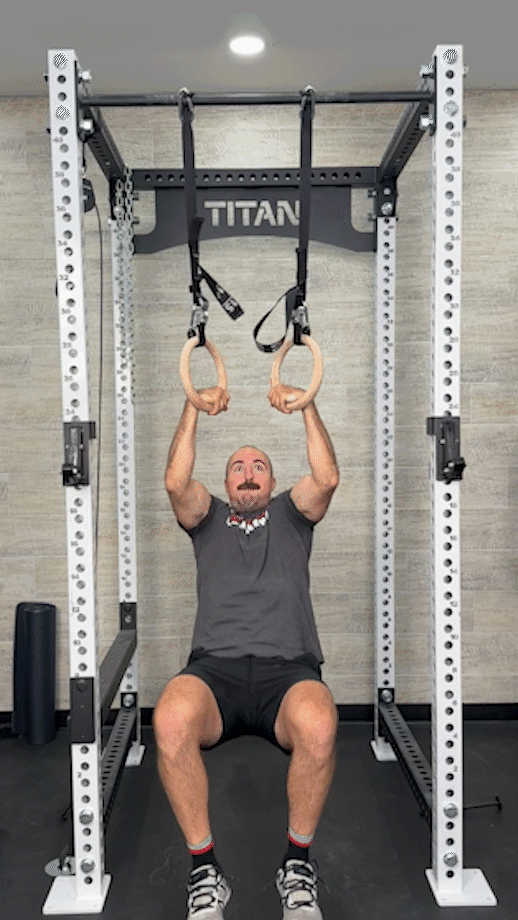
Push-Ups
Push-ups certainly aren’t exclusive to CrossFit athletes. The push-up is hands down one of the best bodyweight exercises for any workout routine, working your arms, chest, shoulders, and core.
RELATED: What Muscles Do Push-Ups Work?
How to do it:
- Get into the push-up position with your palms on the floor.
- Lower your body by bending your elbows. Keep your elbows in line with your torso as you lower yourself to the ground.
- Lightly touch the floor with your chest, then push your body back up.
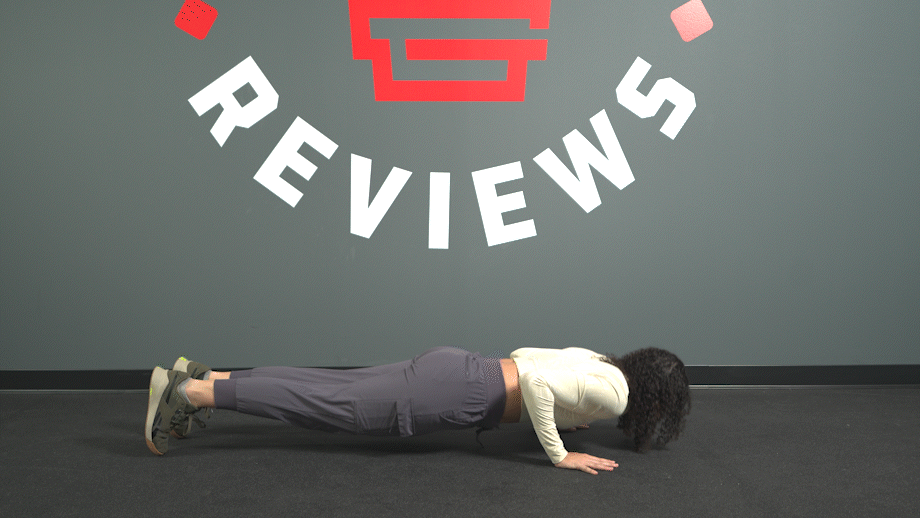
Handstand Push-Ups
Take your standard push-up and flip it on its head, literally. Handstand push-ups involve putting your feet against a wall and lowering your head to the floor.
How to do it:
- Place your hands on the floor and kick your feet up and over your head until they hit the wall in front of you. Hold yourself in a vertical handstand position with your shoulders flexed and arms fully extended.
- Bend your elbows to lower your head to the floor.
- Push your body back up.
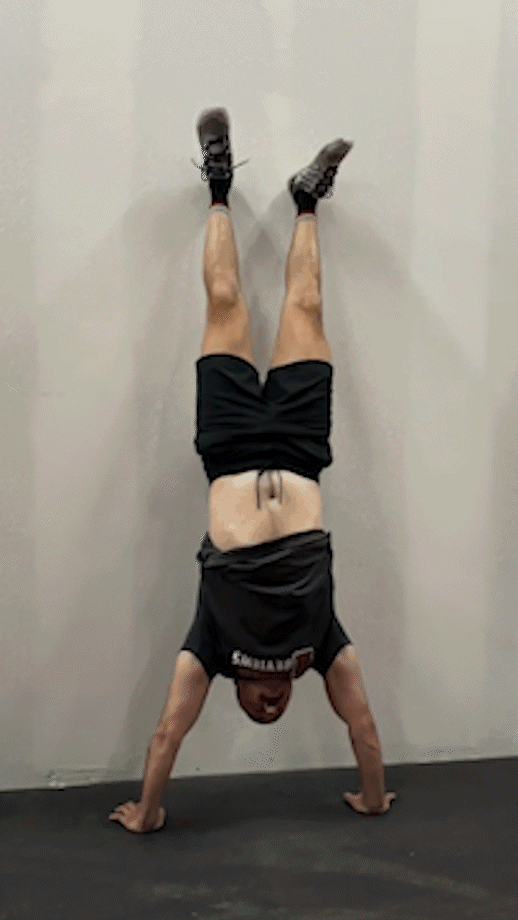
Ring Dips
Ring dips are excellent for your triceps and chest. Because you’re using rings instead of bars, there’s an element of instability, requiring more stabilizing muscles to perform the exercise.
How to do it:
- Adjust a set of gymnastics rings to waist height and grab hold.
- Keeping the rings close to the body, pick your feet up off the floor.
- Slowly lower your body by bending your elbows until they form 90-degree angles.
- Push yourself back up.
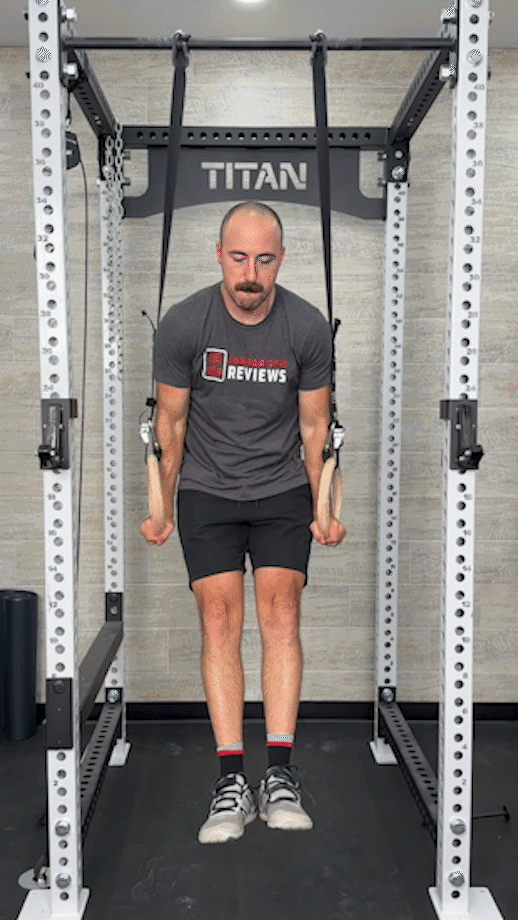
Handstand Walks
Handstand walks are exactly what they sound like—an impressive feat of upper body strength, shoulder stability, balance, and coordination.
How to do it:
- Perform a freestanding handstand.
- Slowly “walk” forward moving one hand at a time.
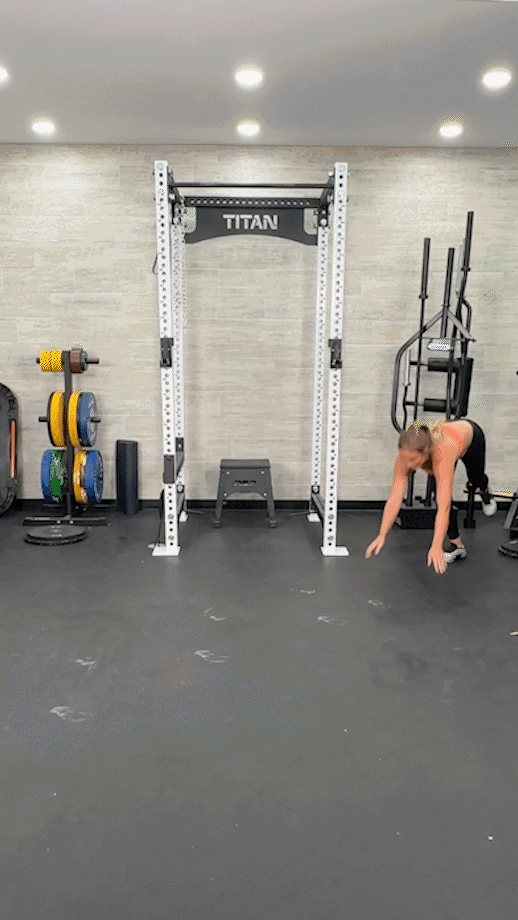
Wall Walks
The wall walk, which involves performing a plank exercise and “walking” your way into a handstand, is a great progression for mastering handstand push-ups or walks.
How to do it:
- Get into a high plank position with your back to a wall.
- Slowly walk one hand at a time toward the wall and one foot up the wall simultaneously.
- Continue until you are vertical with your nose to the wall, then walk your way back.
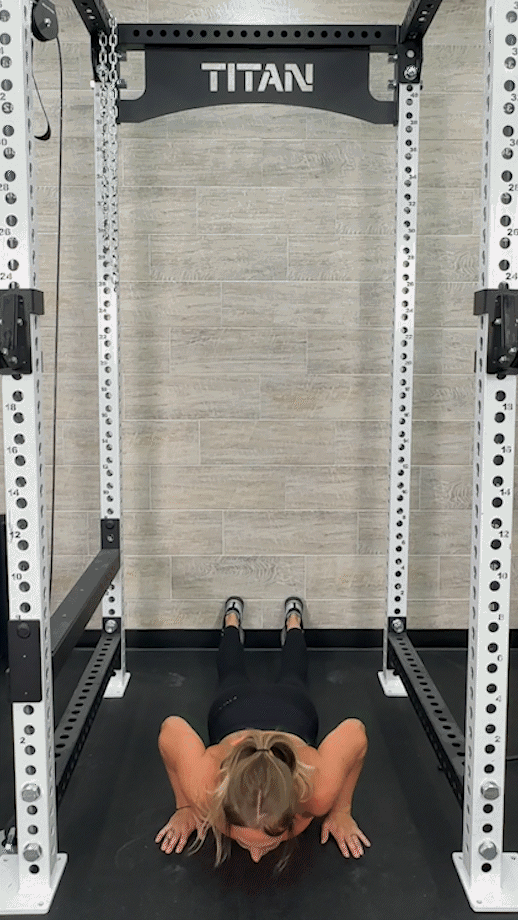
Toes-to-Bar
The toes-to-bar movement involves bringing your toes to a pull-up bar, challenging your upper body, core, and grip strength while building coordination and flexibility. It can be performed strict (without swinging) or by kipping.
How to do it:
- Grab a pull-up bar and begin swinging.
- On the backswing, pull with your arms, engage your core, and bring your toes up so that they tap the bar lightly.
- Swing back down, then cycle into the next rep.
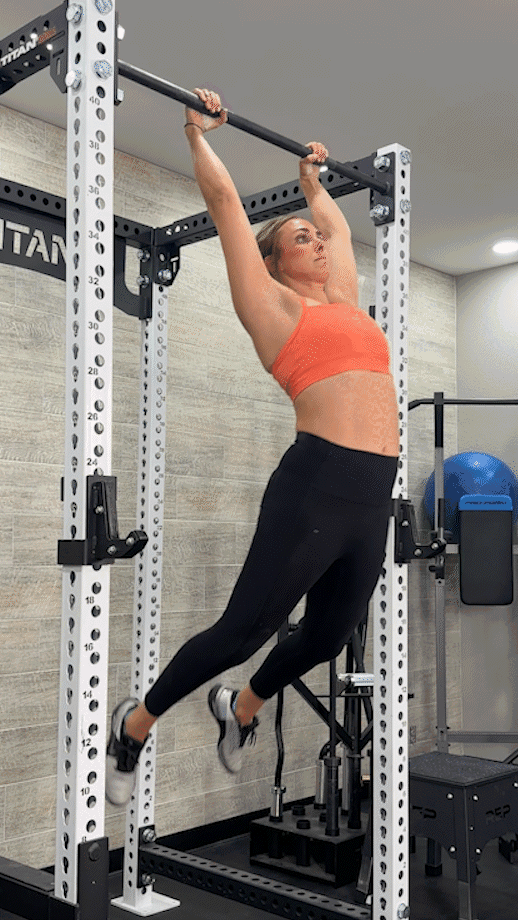
Knees-to-Elbow
Toes-to-bar are challenging. Reducing the range of the motion and bringing your knees to your elbow instead serves as a great modification for beginners.
How to do it:
- Grab a pull-up bar and start swinging.
- On the backswing, bring your knees to your elbows and tap them lightly.
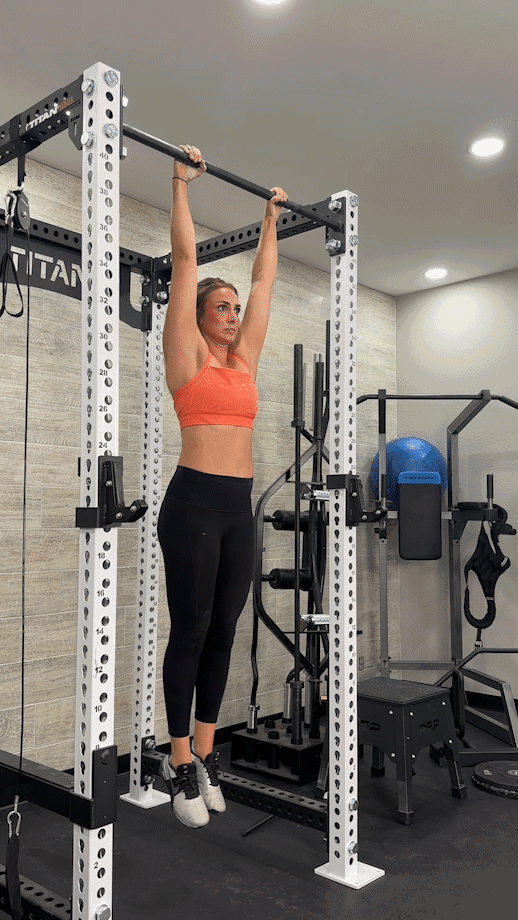
Pistol Squats
A pistol squat is essentially a one-legged air squat. It requires incredible lower body strength, balance, coordination, and ankle mobility.
How to do it:
- Stand on one leg, extending the other straight out in front of your body.
- Hinge your hips forward and bend the knee of your standing leg to squat.
- From the bottom, push through your heel and return to a standing position.
- Switch legs and repeat for the other side.
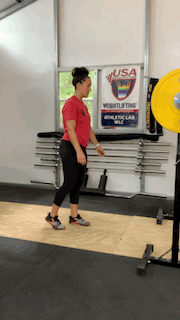
Aerobics
Burpees
The burpees exercise is one of the best CrossFit exercises. This high-intensity bodyweight movement targets various muscle groups, providing a full-body workout.
How to do it:
- Step or jump your feet behind you, dropping into a high plank position.
- Lower your body to the floor, then push yourself back up.
- Step or jump your feet back to center and return to a standing position.
- Jump straight up into the air with your arms raised.
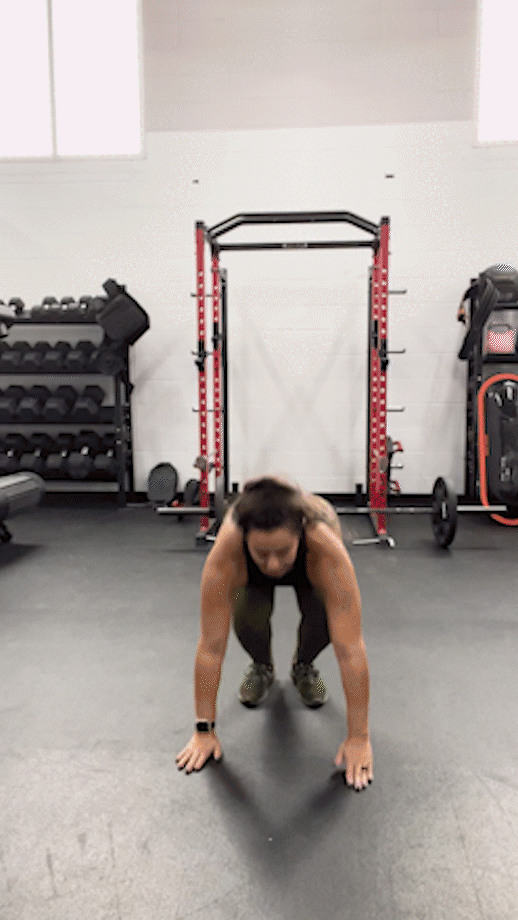
Box Jumps
Box jumps are plyometric exercises that challenge your explosive strength and coordination.
How to do it:
- Place a box on the floor in front of you.
- Explosively jump with both feet so that they land on the box in front of you.
- Stand up fully, extending your hips, to complete the movement.
- Jump or step back down.
RELATED: Best Plyo Boxes
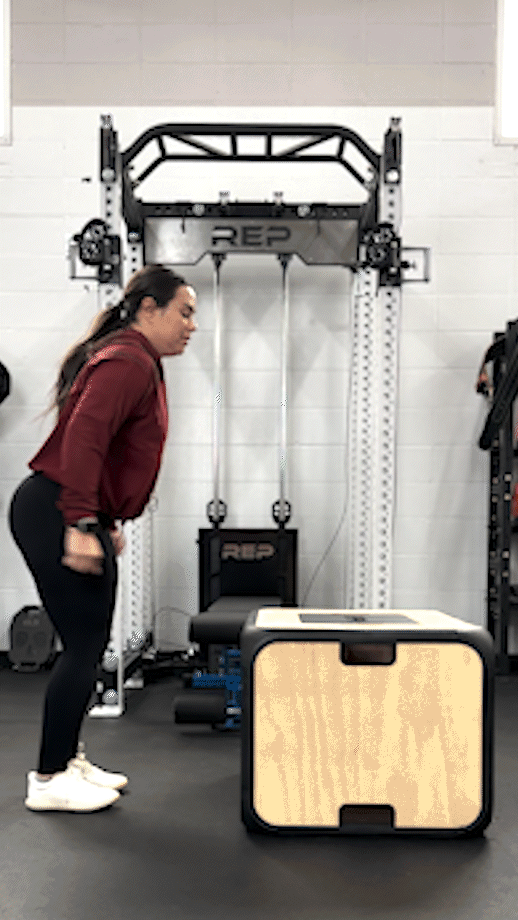
Single-Unders
All you need for a great cardio workout is a jump rope. The term “single-under” refers to jumping rope the regular way, allowing for the rope to pass below your feet only once.
How to do it:
- Select your jump rope.
- Keeping your wrists at your sides, swing the rope from behind you, over your head, and in front of your body.
- Jump over the rope so it passes below you.
- Repeat for desired duration or number of repetitions.
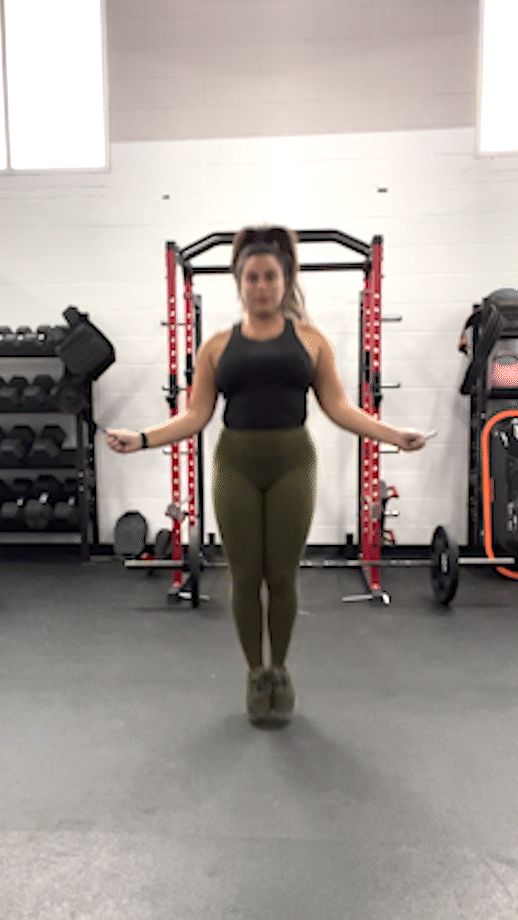
Double-Unders
Double-unders involve jumping rope in such a way that it passes below you twice in a single jump.
How to do it:
- Select your jump rope and jump higher than you normally would.
- Swing the rope fast so that it passes under you twice before you land.
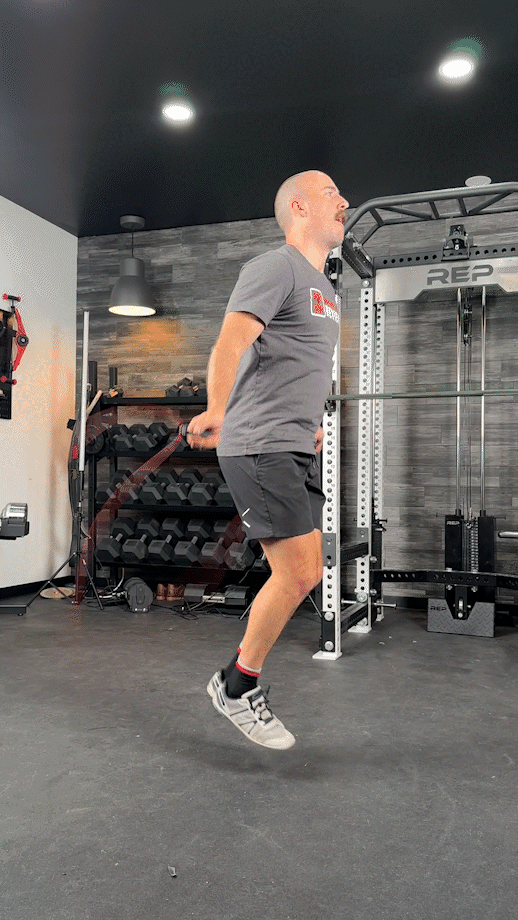
Rowing
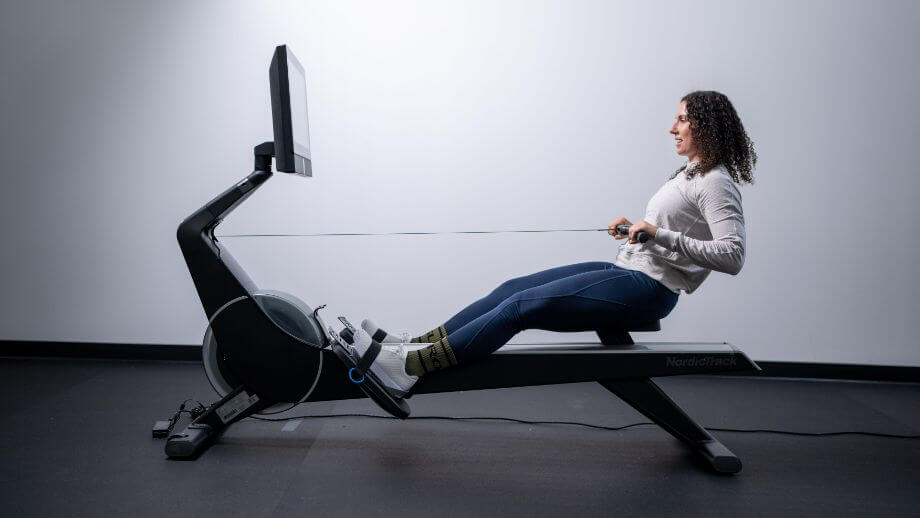
RELATED: 3 Heart-Pumping Rowing Interval Workouts
Rowing is a cardio exercise that uses an ergometer, or rowing machine, and both your arms and legs to perform.
How to do it:
- Adjust the rower to your personal preference, sit down, secure your feet with the footstraps, and grab the handle.
- Push away from the flywheel with your feet as you pull the handle into your chest.
- Once your legs are fully extended, hinge forward, bring your arms forward, and slide back to the starting position.
Assault Bike
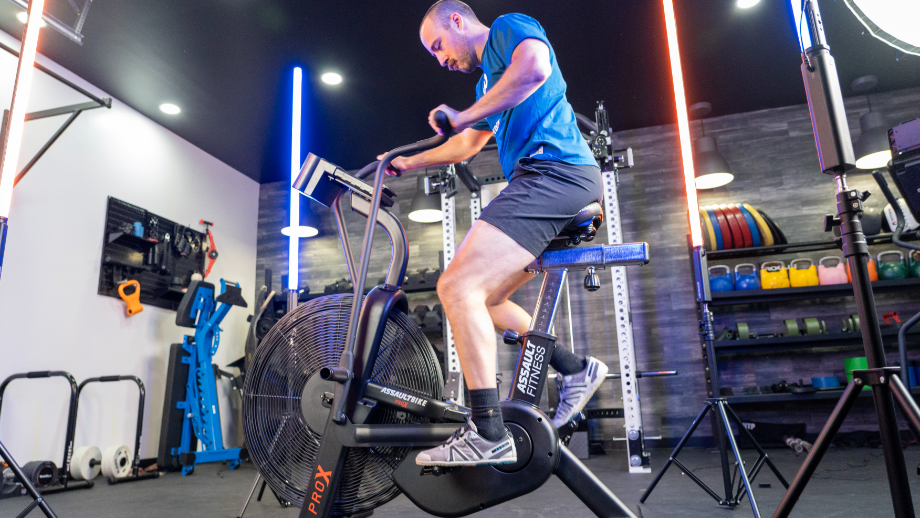
The assault bike is a high-intensity cardio machine that uses wind resistance to become more difficult the harder you pedal.
How to do it:
- Adjust the seat height so your knees stay slightly bent at the lowest point of your pedal stroke. Then, sit down and grab the handles with both hands.
- Pedal, creating equal force with your arms and legs.
- Continue for the desired distance, duration, or calories burned.
RELATED: Best Exercise Bike with Moving Arms
Ski Erg
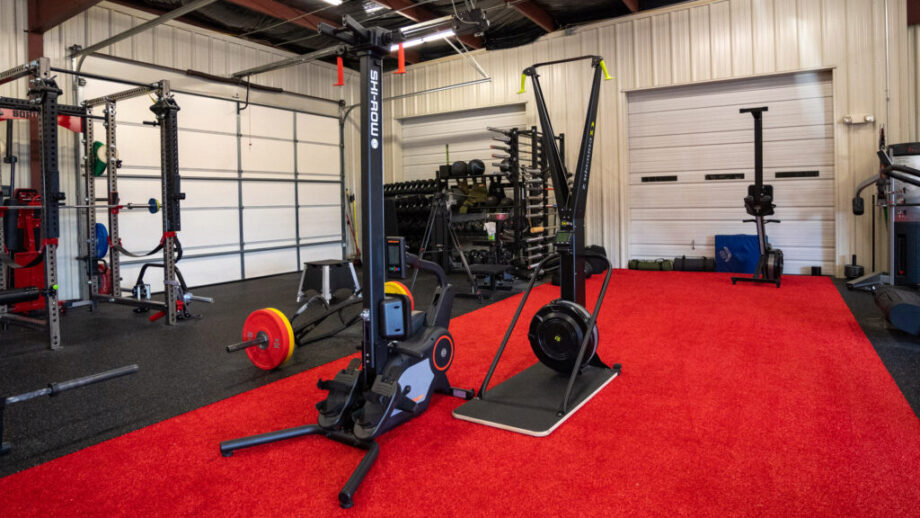
Think of the ski erg as a sort of standing rower that simulates the movement you would perform if you were skiing, thus the name.
How to do it:
- Select your preferred damper setting. The higher the setting, the harder it is.
- Stand in front of the machine, reaching up to grab both handles above your head.
- Hinge forward, tightening your core, as you pull the handles down to your sides.
- Return to the starting position and cycle into the next rep.
Other Exercises
Kettlebell Swings
Kettlebell swings are an all-around great exercise for any workout program. They enhance strength by activating various muscle groups, as well as cardio endurance and stamina.
How to do it:
- Hold a kettlebell in front of your body with both hands.
- Bend your knees, lean forward, then swing the kettlebell upward by thrusting your hips.
- Swing the kettlebell to chest height, then let it fall back down and between your legs.
- Use the momentum to cycle into the next rep, thrusting your hips to launch it again.
RELATED: Best Kettlebells
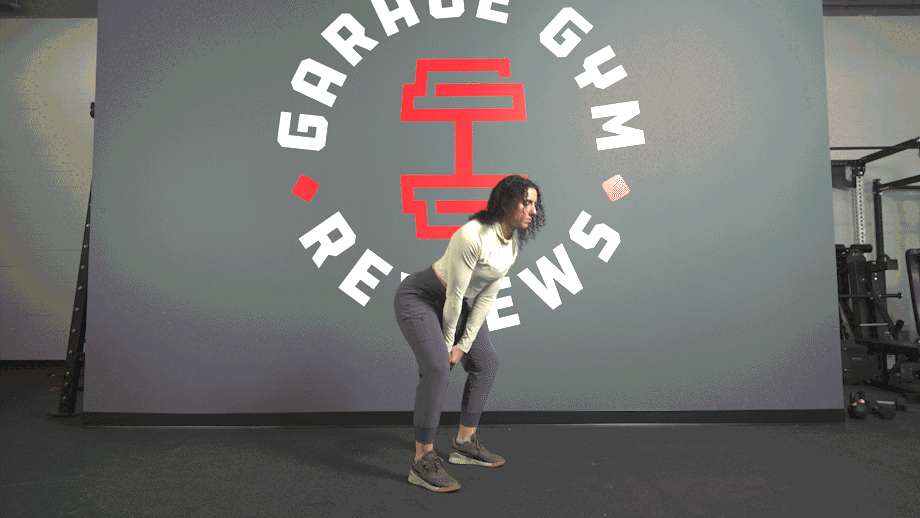
Sumo Deadlift High Pull
A sumo deadlift is a deadlift performed with a wider stance than the conventional deadlift. A high pull involves pulling the barbell to your chin using your arms, shoulders, and upper back muscles. Combine them, and voilà—the sumo deadlift high pull.
How to do it:
- Stand with a barbell at your feet. Your stance should be wider than shoulder-width, but your grip should be more narrow.
- Drive from your heels and lift the barbell off the floor, as you would during the deadlift.
- Pull the bar all the way to your chin, squeezing your traps at the top.
- Slowly return the bar to the floor.
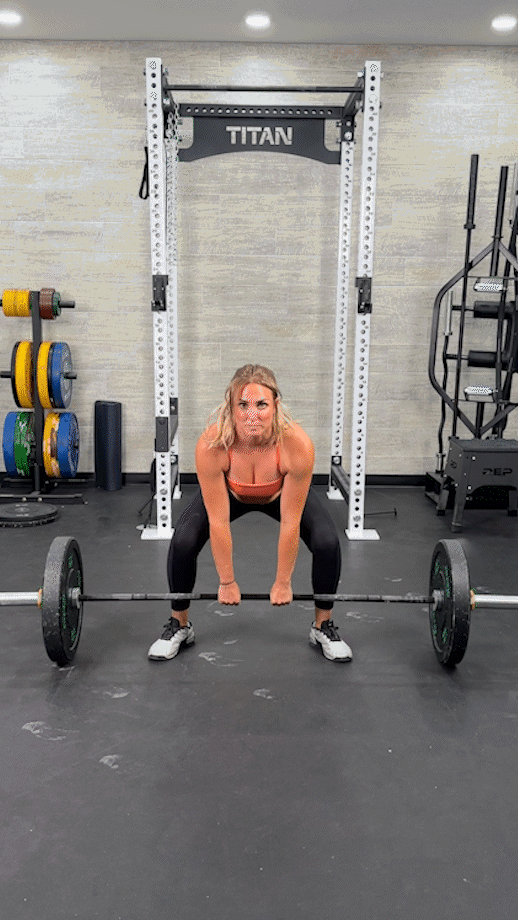
Hollow Rock
The hollow rock is an unassuming floor movement that provides a serious challenge to your core muscles, building strength and stability.
How to do it:
- Lie on your back and lift your arms and legs a few inches off the floor.
- Gently rock back and forth, using your core muscles to control the movement.
- Continue for desired duration or number of reps.
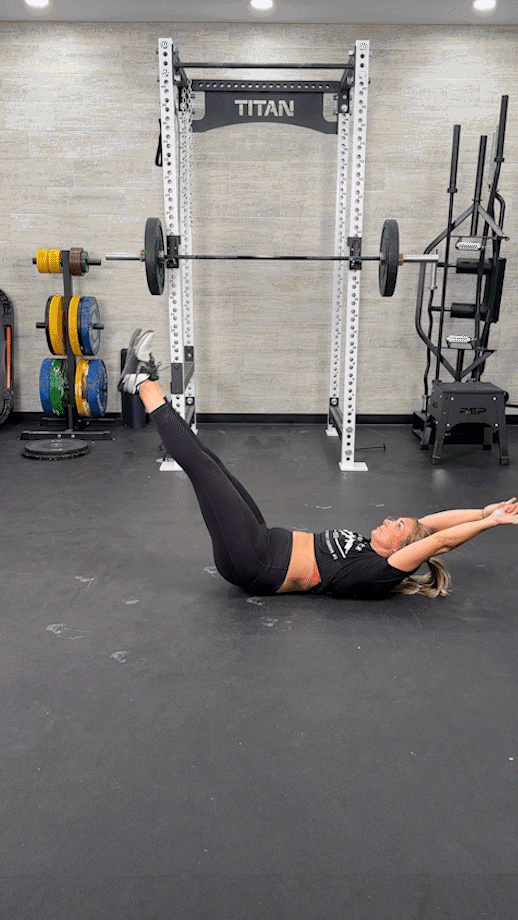
Wall-Balls
Wall balls involve performing an air squat with a medicine ball, then exploding upward to throw the ball into the air so that it bounces off a wall and returns.
RELATED: Medicine Ball Workouts
How to do it:
- Stand in front of a wall while holding a medicine ball to your chest.
- Squat, then explosively drive from your heels and push the ball into the air. Aim to have the ball lightly bounce off the wall approximately nine or ten feet high.
- Catch the ball when it returns, immediately dropping into your next squat to cycle reps.
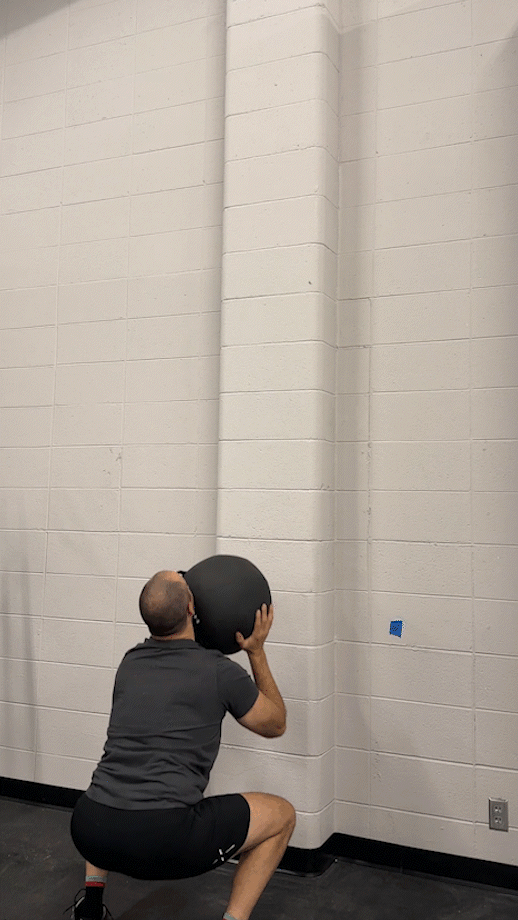
Man-Maker
The man-maker is a full-body workout, combining the renegade row, squat clean, and thruster.
How to do it:
- Select two dumbbells and place them on the floor.
- Jump or step your feet back, grabbing each dumbbell as you enter a high plank position.
- Row one dumbbell into your chest, then the other.
- Jump or step your feet back to center, then squat clean the dumbbells. Keep them close to the body during the clean, and finish this step in a squat position.
- From the bottom of your squat, drive from your heels to explode upward, coming up onto your toes as you propel the dumbbells overhead.
- Bring the dumbbells back to your shoulders, reverse the movement to place them back on the floor, and cycle into your next rep.
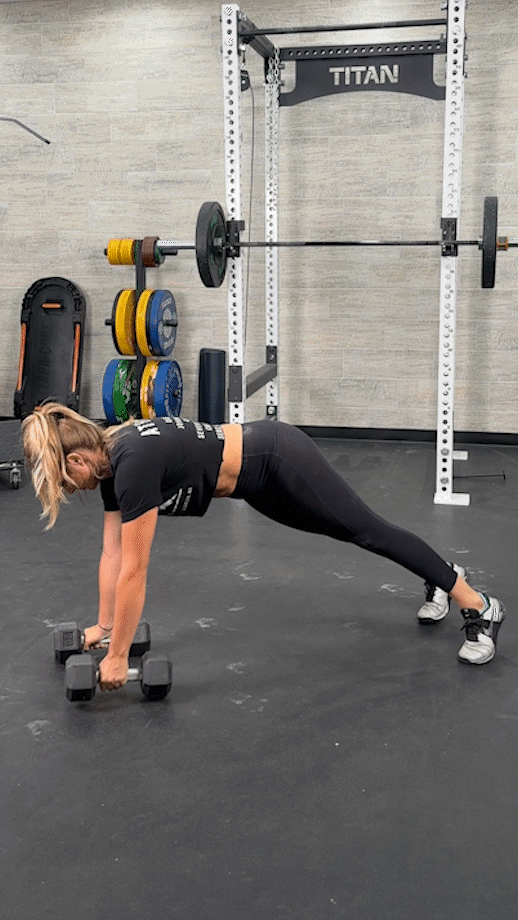
Devil’s Press
The devil’s press combines the burpee with a double dumbbell swing to the overhead position.
How to do it:
- Select two dumbbells and place them on the floor.
- Jump or step your feet back, grabbing each dumbbell as you move. Let your body come completely in contact with the floor, just as you would during a burpee.
- Push your body back up, jumping or stepping your feet back to center.
- As you stand, swing the dumbbells between your legs and up into an overhead lockout position. Keep them close to the body during the swing, as though cleaning and jerking the dumbbells in one fluid motion.
- Reverse the movement to return the dumbbells to the floor.
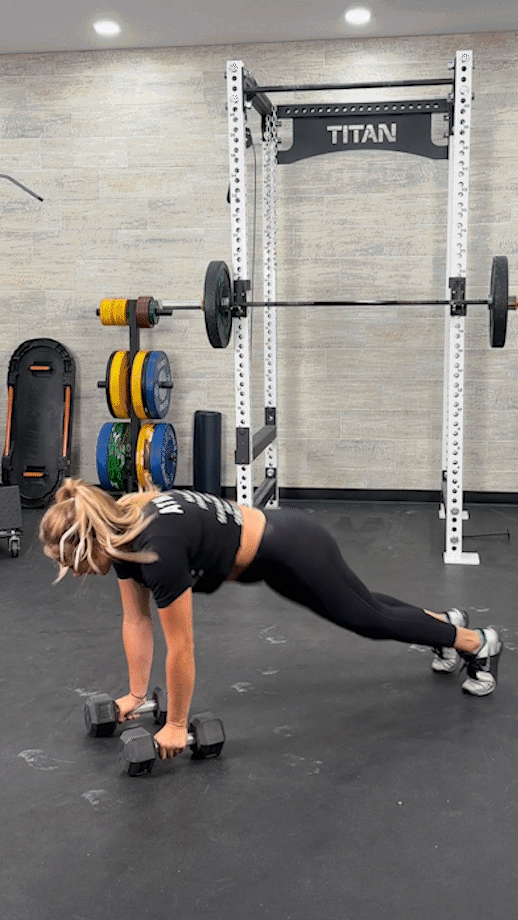
CrossFit Exercises: Final Thoughts
Staying “constantly varied” isn’t so difficult when you have this many exercises to choose from, but exercise diversity is only part of what makes CrossFit such an effective program.
CrossFit also blends elements of HIIT, Olympic weightlifting, functional movements, and a strong sense of community to create one of the best fitness experiences you’ll find anywhere.
Not sure if CrossFit is for you? Drop in for a class at your local CrossFit box, or try out some of the CrossFit exercises we listed above to see if it’s something you might be interested in.
What do you have to lose?
CrossFit Exercises: FAQs
Can beginners do CrossFit?
Absolutely.
CrossFit incorporates some technical movements and lifts in their training program, but coaches offer comprehensive instruction, breaking things down step by step before you’re expected to perform the movement.
Plus, everything and anything that’s beyond your abilities can be modified or substituted so that you will still get an excellent workout that supports your goals, regardless of your fitness level.
Is CrossFit bad for you?
Rumors over the years allege that CrossFit is dangerous because it encourages CrossFitters to perform technical exercises, often with heavy weights, as fast as possible, which may result in them neglecting proper form and leading to injury.
A 2018 study published in the Journal of Sport Rehabilitation3 dismissed this rumor, stating that “the risk of injury from participation in CrossFit is comparable to or lower than some common forms of exercise or strength training.”
If all exercises are performed properly and responsibly, CrossFit poses no greater risk to your health than any other form of exercise or strength training.
RELATED: Is CrossFit Bad For You?
Is CrossFit the fastest way to get in shape?
Studies show4 that CrossFit has a positive effect on “cardiovascular [and] respiratory endurance, stamina, strength, flexibility, power, speed, coordination, agility, balance, and accuracy,” but that’s not all; CrossFit also has a positive effect on your “sense of community, satisfaction, and motivation,” meaning you’re more likely to start training and stay committed!
References
1. Baz-Valle E, Schoenfeld BJ, Torres-Unda J, Santos-Concejero J, Balsalobre-Fernández C. The effects of exercise variation in muscle thickness, maximal strength and motivation in resistance trained men. PLoS One. 2019;14(12):e0226989. Published 2019 Dec 27. doi:10.1371/journal.pone.0226989
2. Mazeas A, Duclos M, Pereira B, Chalabaev A. Evaluating the Effectiveness of Gamification on Physical Activity: Systematic Review and Meta-analysis of Randomized Controlled Trials. J Med Internet Res. 2022;24(1):e26779. Published 2022 Jan 4. doi:10.2196/26779
3. Klimek C, Ashbeck C, Brook AJ, Durall C. Are Injuries More Common With CrossFit Training Than Other Forms of Exercise?. J Sport Rehabil. 2018;27(3):295-299. doi:10.1123/jsr.2016-0040
4. Claudino JG, Gabbett TJ, Bourgeois F, et al. CrossFit Overview: Systematic Review and Meta-analysis. Sports Med Open. 2018;4(1):11. Published 2018 Feb 26. doi:10.1186/s40798-018-0124-5


